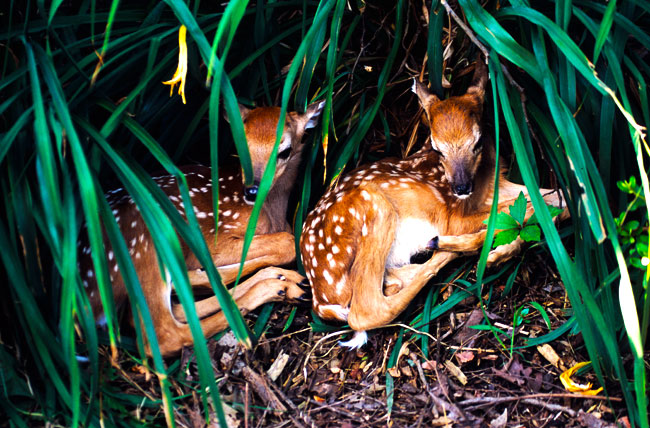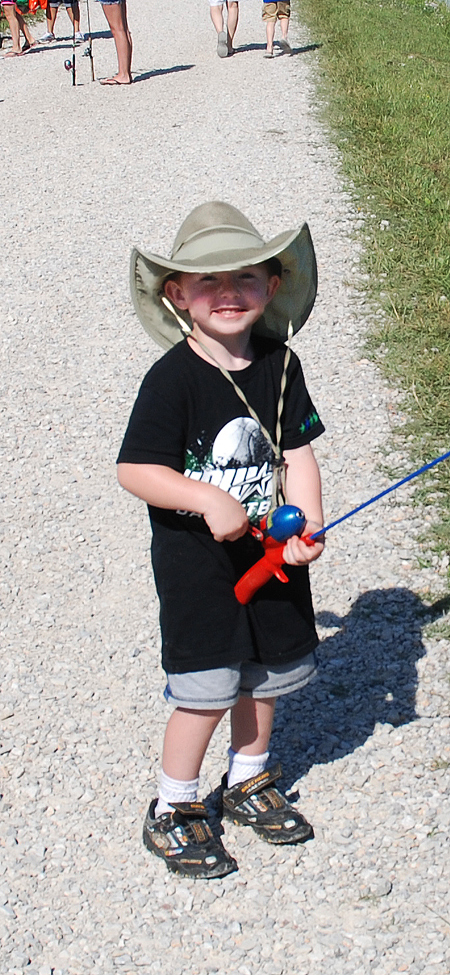
June 9, 2011 Contact: Art Lander, Jr.
FOR IMMEDIATE RELEASE 1-800-858-1549, ext. 4414
FRANKFORT, Ky. – Everything is “growing like a weed,” as the old saying goes, because of heavy rainfall in April and early May followed by unseasonably high temperatures in early June.

Fields of fescue grass, timothy, clover and alfalfa are tall and lush. The prime time for that first cutting of hay has come earlier than normal.
Landowners are reminded as they go about mowing and cutting hay that deer are with newborn fawns and some wild turkeys may be nesting or re-nesting.
Cool, wet conditions along with localized flooding and nest predation caused some turkeys to lose their first clutch of eggs.
“Those hens will be on the nest or with young poults throughout this month,” said Steven Dobey, wild turkey program coordinator for the Kentucky Department of Fish and Wildlife Resources. “If a turkey nest with eggs is encountered, or accidentally run over while mowing, remember that it’s illegal to possess or hatch wild turkey eggs.”
Dobey’s advice is to avoid or postpone mowing likely nesting areas until the end of the month – if feasible – when young turkeys are more mobile.
Young turkeys cannot fly for the first two to three weeks after hatching.
“With all the rain we had, this is the first real chance to cut hay before grasses go to seed. It couldn’t have come at a worse time,” said Joe Lacefield, a private lands wildlife biologist for Kentucky Fish and Wildlife.
Many pastures are a mix of fescue and clover, which turkeys often use to nest. Mowing endangers their clutch.
“Their best chance to avoid predators is to nest out in the middle of fields, instead of along woodlands and weedy edges,” said Lacefield, who works in eight central Kentucky counties. “There’s a much higher presence of nest predators such as raccoons, foxes and coyotes along the edge.”
Lacefield said landowners can plant native grasses to avoid having to mow when turkeys and small game may be nesting and deer are fawning. “Native grasses can be cut later, in early July, and you’ll still get quality hay,” he explained.
David Yancy, senior deer biologist with Kentucky Fish and Wildlife, said deer fawning peaks in mid-June. His advice is also to defer mowing until the beginning of July.
“For about the first two weeks after they are born, fawns are hidden away in weeds and tall grass,” said Yancy. “After that they tend to get up and run from danger.”
Newborn fawns lay motionless in thick cover away from their mothers. They attract less attention from predators that way, but that makes them vulnerable to mowing as well.
“Fawns that are hiding in the weeds aren’t abandoned. The mother is in earshot. She comes in to nurse and groom the fawn two to three times a day,” said Yancy. “She’s staying away from the fawn because she doesn’t want to draw attention to its location.”
It will be August or September before fawns are strong enough to run at their mother’s side.
Landowners are reminded that it’s illegal to “adopt” a deer fawn.
“The only people that can possess and raise a deer fawn are licensed wildlife rehabilitators,” said Yancy.
This spring’s unusual weather could have a silver lining for small game. “The flush of vegetation is a good thing because it provides food and shelter for rabbits and quail,” said Ben Robinson, small game biologist for Kentucky Fish and Wildlife. “It’s shaping up to be an excellent nesting year. Rabbits have already pulled off at least one litter and our peak of quail nesting won’t occur until late June or July.”
Delay mowing in sensitive areas to help small game, turkey and deer populations thrive. Fewer disturbances from mowing now brings better hunting later.
Author Art Lander Jr. has been writing about the outdoors since the 1970s. He is a staff writer for Kentucky Afield magazine.
-30-
The Kentucky Department of Fish and Wildlife Resources manages, regulates, enforces and promotes responsible use of all fish and wildlife species, their habitats, public wildlife areas and waterways for the benefit of those resources and for public enjoyment. Kentucky Fish and Wildlife is an agency of the Tourism, Arts and Heritage Cabinet. For more information on the department, visit our website at fw.ky.gov.




Be the first to comment